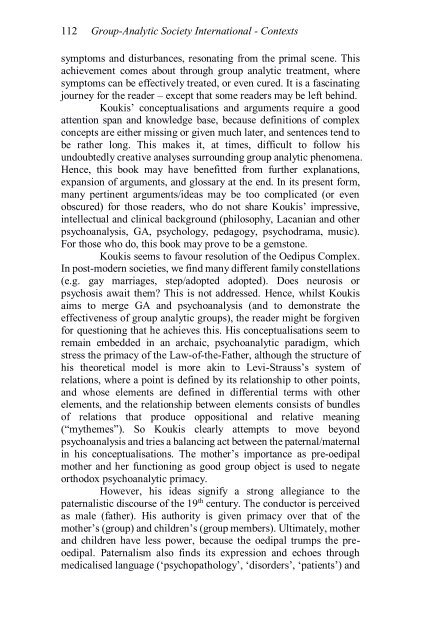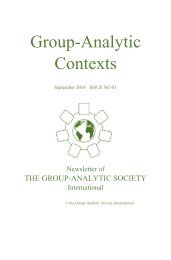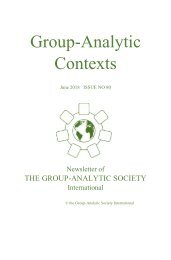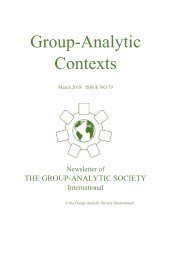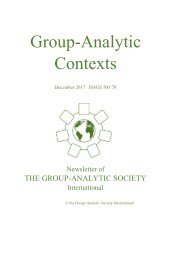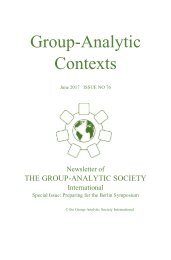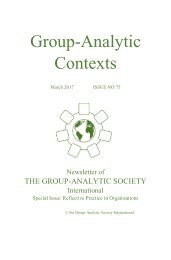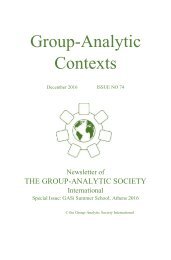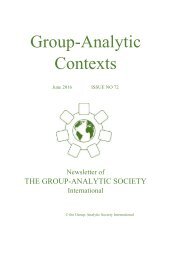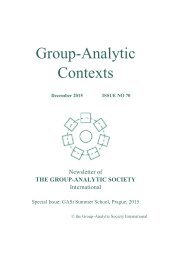Group Analytic Contexts, Issue 77, September 2017
Newsletter of the Group Analytic Society International
Newsletter of the Group Analytic Society International
You also want an ePaper? Increase the reach of your titles
YUMPU automatically turns print PDFs into web optimized ePapers that Google loves.
112 <strong>Group</strong>-<strong>Analytic</strong> Society International - <strong>Contexts</strong><br />
symptoms and disturbances, resonating from the primal scene. This<br />
achievement comes about through group analytic treatment, where<br />
symptoms can be effectively treated, or even cured. It is a fascinating<br />
journey for the reader – except that some readers may be left behind.<br />
Koukis’ conceptualisations and arguments require a good<br />
attention span and knowledge base, because definitions of complex<br />
concepts are either missing or given much later, and sentences tend to<br />
be rather long. This makes it, at times, difficult to follow his<br />
undoubtedly creative analyses surrounding group analytic phenomena.<br />
Hence, this book may have benefitted from further explanations,<br />
expansion of arguments, and glossary at the end. In its present form,<br />
many pertinent arguments/ideas may be too complicated (or even<br />
obscured) for those readers, who do not share Koukis’ impressive,<br />
intellectual and clinical background (philosophy, Lacanian and other<br />
psychoanalysis, GA, psychology, pedagogy, psychodrama, music).<br />
For those who do, this book may prove to be a gemstone.<br />
Koukis seems to favour resolution of the Oedipus Complex.<br />
In post-modern societies, we find many different family constellations<br />
(e.g. gay marriages, step/adopted adopted). Does neurosis or<br />
psychosis await them? This is not addressed. Hence, whilst Koukis<br />
aims to merge GA and psychoanalysis (and to demonstrate the<br />
effectiveness of group analytic groups), the reader might be forgiven<br />
for questioning that he achieves this. His conceptualisations seem to<br />
remain embedded in an archaic, psychoanalytic paradigm, which<br />
stress the primacy of the Law-of-the-Father, although the structure of<br />
his theoretical model is more akin to Levi-Strauss’s system of<br />
relations, where a point is defined by its relationship to other points,<br />
and whose elements are defined in differential terms with other<br />
elements, and the relationship between elements consists of bundles<br />
of relations that produce oppositional and relative meaning<br />
(“mythemes”). So Koukis clearly attempts to move beyond<br />
psychoanalysis and tries a balancing act between the paternal/maternal<br />
in his conceptualisations. The mother’s importance as pre-oedipal<br />
mother and her functioning as good group object is used to negate<br />
orthodox psychoanalytic primacy.<br />
However, his ideas signify a strong allegiance to the<br />
paternalistic discourse of the 19 th century. The conductor is perceived<br />
as male (father). His authority is given primacy over that of the<br />
mother’s (group) and children’s (group members). Ultimately, mother<br />
and children have less power, because the oedipal trumps the preoedipal.<br />
Paternalism also finds its expression and echoes through<br />
medicalised language (‘psychopathology’, ‘disorders’, ‘patients’) and


